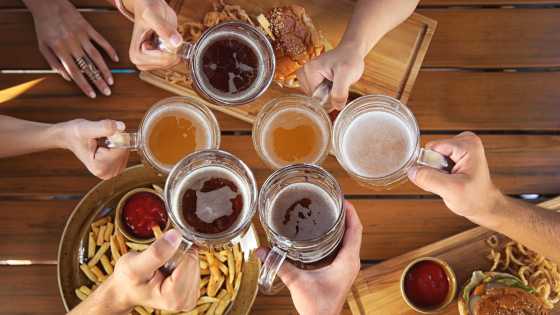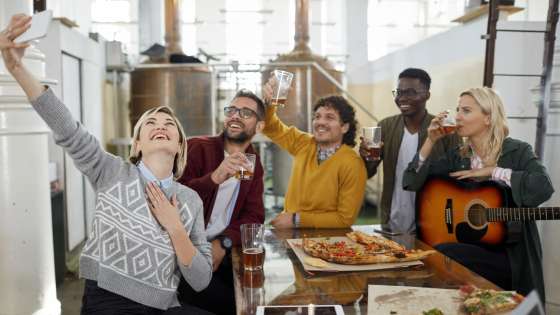Beyond the Pint: Tips on Crafting a Brewery Food Program for Strategic Advantage

When pairing the perfect brewery food program with your cold, craft beers, breweries like you have a unique opportunity to elevate the drinking experience and experience growth in your business. Shifting from a production-focused brewery to an experience-driven destination—or brewpub—isn’t just a passing trend; it’s a smart move in response to changing market demands. At the heart of this evolution is food. It’s more than just a menu add-on—it’s a powerful differentiator, a major revenue driver, and a key to building customer loyalty.
This blog breaks down the benefits of launching a successful food program, provides inspiration for food pairings and menu planning, and gives insight into the impact of food-focused events.
What are the Benefits of Creating a Brewery Food Program?
The global craft beer market was valued at over $107 billion in 2024 and is expected to nearly double, reaching close to $243 billion by 2033. But with nearly 9,800 craft breweries operating across the country and overall growth beginning to slow, the industry is becoming more competitive than ever. Today, brewing great beer isn’t enough on its own. Consumers are looking for more—unique experiences, engaging environments, and community-driven spaces to gather—turning breweries into vibrant social hubs rather than just places to grab a pint.
A well-conceived food menu serves multiple critical functions:
- Elevating the Experience: Thoughtfully prepared food intrinsically complements the beer portfolio, encouraging guests to extend their stay and immerse themselves fully in the brewery’s atmosphere. It transforms a simple drink into a more complete social and sensory occasion.
- Broadening Appeal: While craft beer remains the core offering, incorporating appealing food options significantly widens the brewery’s customer base. It attracts families, groups with diverse preferences, and individuals who might not visit solely for the beer, making the establishment more inclusive and community-oriented. This is particularly vital as breweries seek to differentiate themselves in a crowded marketplace.
- Revenue Diversification and Growth: Food introduces substantial additional revenue streams, bolstering the bottom line. This is especially crucial for breweries relying heavily on taproom sales and those hosting private events. The Brewers Association noted that the 3% increase in craft retail dollar sales in 2023 was partly driven by stronger onsite sales growth – precisely where food programs make an impact.
- Meeting Consumer Demand for Experiences: Modern consumers, particularly millennials who are key craft beer drinkers, increasingly seek unique, authentic experiences and value local connections. A food program focused on quality, local sourcing, and creative pairings directly addresses this demand.
Inspiration for Adding a Brewery Food Program
Creating a food menu that pairs seamlessly with your beer offerings is more than just a smart business move—it’s an opportunity to craft a complete and memorable guest experience. The right menu can elevate your brewery, deepen customer satisfaction, and increase your revenue potential, especially when it comes to hosting events. Here are some expert-backed ideas to help you get started:
1. Celebrate Local Flavors
Start by showcasing what makes your region unique. Incorporating locally sourced cheeses, meats, produce, and other ingredients not only supports nearby farmers and artisans but also tells a story with every plate. Guests love knowing where their food comes from, and regional touches can set your menu apart from the rest.
2. Build Around Your Beer
Design your menu with your beer lineup in mind. Consider the flavor profiles of your brews—whether it’s a crisp pilsner, a hoppy IPA, or a rich stout—and create pairings that highlight and enhance each other. When done well, the food and beer work together to deliver a layered, flavorful experience that keeps guests coming back.
3. Offer Shareable, Social Plates
Encourage communal dining with shareable options. Think elevated bar snacks, charcuterie boards, beer cheese pretzels, or flatbreads topped with seasonal ingredients. Shareable plates invite conversation, create a relaxed, social vibe, and allow guests to sample a wider variety of dishes (and beers!).
4. Accommodate All Diets
Today’s guests expect thoughtful options for every dietary need. Offering well-executed vegetarian, vegan, and gluten-free dishes not only shows that you care but also ensures that everyone feels welcome. Items like roasted veggie tacos, quinoa grain bowls, and gluten-free beer-battered apps can be both inclusive and delicious.
5. Cook with Beer
Take things to the next level by using your own beers as ingredients. From IPA-marinated wings to stout chili or porter brownies, cooking with beer reinforces your brand, adds depth to familiar dishes, and creates a stronger connection between the food and drink offerings.
6. Keep It Seasonal and Streamlined
A seasonal menu keeps things fresh—for your guests and your kitchen. Rotate dishes based on what’s in season and what pairs best with your current beer lineup. A smaller, focused menu also allows your kitchen to execute consistently and efficiently.

Types of Food-focused Events at Your Brewery
Breweries can utilize a diverse array of food-centric events to engage patrons, ranging from highly curated, premium experiences to more casual, community-focused gatherings. The specific types of events employed often reflect the brewery’s brand identity, operational capabilities, and target audience.
Here’s some thoughts around using food-centric events at your business.
Beer Pairing Dinners
These events represent a sophisticated approach to integrating food and beer, typically involving multi-course meals where specific brews are meticulously matched with complementary dishes. Such dinners often necessitate collaboration with skilled chefs, either from an in-house team or through partnerships with local restaurants or culinary professionals. The goal is to create an immersive dining experience that not only satisfies the palate but also educates guests on the nuances of beer flavors and their interaction with food, highlighting the complexity and versatility of the brewery’s offerings. Examples include themed pairings for occasions like Valentine’s Day (e.g., cheesecake or chocolate pairings) or events built around seasonal ingredients or beer releases. These dinners position the brewery as a destination for elevated culinary experiences.
Food Truck Rallies & Partnerships
A prevalent model, particularly for breweries lacking dedicated kitchen facilities, involves partnering with food trucks. This approach offers significant flexibility, allowing breweries to provide diverse and rotating menu options (e.g., tacos one day, BBQ the next) without the substantial overhead of an in-house kitchen. Breweries can leverage the existing customer base of popular food trucks, creating a mutually beneficial arrangement that drives traffic to both businesses. Food truck rallies, featuring multiple vendors, can generate a lively, festival-like atmosphere, attracting larger crowds. This symbiotic relationship allows breweries to enhance their offerings while supporting other local businesses.
Special Menu Collaborations
Breweries may collaborate directly with local restaurants, chefs, or specialty food producers to create unique menu items or host limited-time culinary events. This can take the form of cross-promotional bundles (e.g., beer and cheese pairings with a local shop) or more elaborate “four-hands” dinners featuring multiple chefs. Such collaborations leverage external culinary expertise and tap into the partner business’s customer base, fostering valuable community partnerships and generating unique offerings.
Themed Food Nights
These events, often recurring, center around specific cuisines or food types, such as Taco Tuesdays, BBQ nights, or seasonal celebrations like Oktoberfest featuring traditional German fare. These themes provide a consistent draw and are relatively straightforward to market, often paired with specific beer styles or new releases to enhance the thematic experience.
Pop-Ups
Pop-up food concepts offer a temporary, often novel, culinary experience within the brewery. Featuring guest chefs, unique themes, or experimental menus, pop-ups generate excitement and can attract diverse crowds seeking new experiences. This format allows breweries to test food concepts, gauge customer interest, or collaborate with culinary partners on a short-term basis with minimal long-term commitment.
Brewery Festivals with Food Components
Larger-scale events, sometimes involving multiple breweries, frequently incorporate a significant food element. These festivals typically feature a variety of food trucks or vendors alongside extensive beer-tasting options, live music, and other entertainment. While demanding considerable planning and resources, such festivals can create substantial community buzz and attract significant regional attention.
Private Events
Birthday parties, anniversaries, weddings, and corporate events are not just celebrations—they’re prime opportunities to showcase your brewery’s unique atmosphere and offerings. With their laid-back vibe and built-in entertainment, breweries are becoming highly desirable destinations for hosting unforgettable events.
Ready to Host Events at Your Brewery? Tripleseat Makes It Easy
Turn great food and beer into unforgettable moments by hosting food pairing events, brewer’s dinners, or tasting menus. These events not only drive revenue but also build community and deepen guest loyalty. Featuring your chefs and brewers as hosts gives guests a behind-the-scenes connection to the craft.
Are you ready to grow your event business? Schedule a Tripleseat demo to take a closer look at our event management features.
